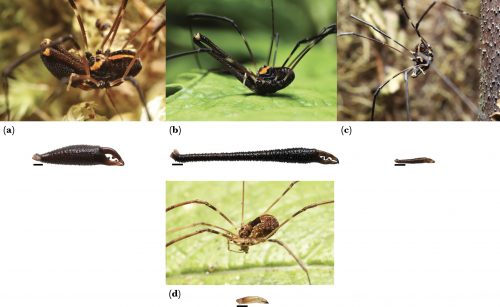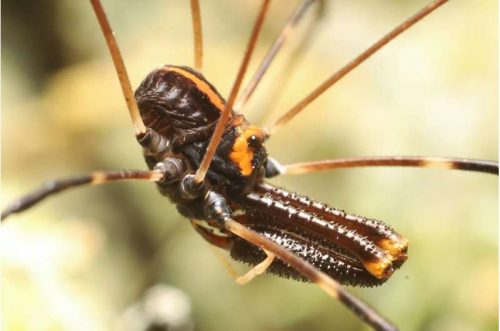Lately, I’ve been curious about this one species of spiders I’ve been breeding, Steatoda borealis. What makes them stand out compared to the other two species in the lab is the size of their palps — they’re significantly larger in S. borealis. It’s got me wondering why they have these massive spiky hooked medieval maces on their faces, where other species have prominent, distinctive bulbs but nothing of the magnitude of this one set of males.
Then I see this species of harvestmen that put my spiders to shame. Look at this gigantic apparatus on the animal’s head! It can be up to 50% of their body weight!
The surprised don’t end there. These harvestmen have three distinct kinds of males, alpha, beta, and gamma, all distinguishable by the morphology of their genitals, and then there are females, of course (only one flavor, though). So four sexes?

Intraspecific variation in the New Zealand harvestman Forsteropsalis pureora: (a) alpha male (major), (b) beta male (major) (c) gamma male (minor), and (d) female. The second cheliceral segment representative of alphas, betas, gammas, and females is shown underneath the corresponding in situ photograph. Scale bars indicate 1 mm.
So how did this state of affairs come about? Fighting. The males engage in combat to gain access to females. This is a familiar strategy — you’ve got the big bruisers who go straight into battle with their rivals, and while they’re thus engaged, you’ve got the gracile sneaker males who dart in and have sex. Those big genitals are costly and tactics that don’t require that kind of investment are advantageous. We’ve seen similar phenomena in beetles and squid.
Alpha and beta males can have a body mass up to seven times higher than that of gamma males, demonstrating the drastic intraspecific variation found in this species. Gamma males adopt a scrambling strategy, searching through their environment to find mates and avoiding contests with other males, while alpha and beta males use their exaggerated chelicerae as weapons in contests to access females.
Awesome. Now I’m thinking that maybe S. borealis exhibits a pattern of combat that has driven the evolution of more exaggerated genitals. It’s not the only possibility, though — the females of this species are also fairly large and powerfully built. So who’s fighting whom?
I may have an excuse to set up some cage matches in the lab.



Are you talking about their chelicerae? I don’t think they are used to transfer sperm.
Squid or Cuttlefish or both?
Yeah, not strictly speaking “genitals”, more like sex-associated wrestling apparatus.
If someone doesn’t start a band called “sex-associated wrestling apparatus” then the world will be immeasurably the poorer.
That’s precisely what I said, then she slapped me.
Fascinating: are the differences between the three types of males innate or acquired?
That’s what the paper is about: they argue that incidents of autotomy, when legs are lost, make it far more likely that the male will adopt one of the ‘minor’ morphs.
This morning, I learned how a species of sea worm has learned to avoid the ordeal of mating battles and/or growing exaggerated genitalia.
They let the genitalia part of the body grow eyes and tentacles, and swim away to do its own thing!
This is almost as clever as the “electric monk” concept of Douglas Adams.
https://phys.org/news/2023-11-sea-worm-posterior-scientists.html
I am reminded of Oklahoma Senator Markwayne Mullin. He’s a small guy, but instead of being smart like a spider, he’s trying to square off in a physical contest he absolutely cannot back up with the head of the Teamsters.
Artor @ 9, as I recall, Mullin did fight in a handful (OK, 3) of MMA matches and won. So, he might’ve gotten in a lucky punch with the Teamsters head.
Then, learn that a street fight and a ring fight are two entirely different creatures. But then, that idiot thinks that Jackson beating another member of Congress nearly to death is allowable and good. Guess machine guns at 10 paces would be better.
Those big genitals are costly and tactics that don’t require that kind of investment are advantageous.
So what keeps the backdoor Romeos from terminally outbreeding the eight-legged Johnny Wadds? Do the ladies show any preferences?
The gamma males do have lower reproductive success. According to the paper becoming a gamma is something they do if they lose legs during earlier devolopment, to be able to get at least some mating success, since they wouldn’t be able to compete if trying to become an alpha.
The same could be said for antlers for example.
I have now got the concept of a “Rage Wang” in my head, and THAT ain’t going away.
Louis
So I’m a lover not a fighter is totally a thing. I dig it.
@ 8. birgerjohansson :
Reminds me of the classic old Detachable penis song by King missile
When I commuted to UC Santa Cruz from Pacific Grove, a fifty mile drive, I had an old car with only AM radio. There was only one decent music station that I could pick up, and the early morning DJ apparently really liked “Detatchable Penis” so I often heard it on the way to school. Unfortunately I have a bad habit of picking up ear worms and quietly singing them. I had to be really careful some mornings when it played as I arrived at the parking lot.